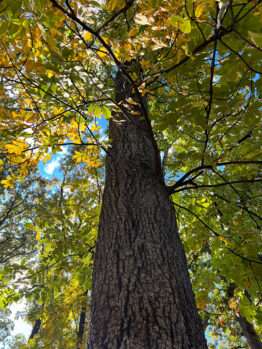Mockernut Hickory
Researched by Harley Rosenzweig
 Species: Carya tomentosa
Species: Carya tomentosa
Common name: Mockernut hickory, white hickory
Family: Juglandaceae (Walnut Family)
Clade: Angiosperms (flowering seed plants)
Coordinates: 39.7081122, -75.11840268
A tag using this number is placed near the tree.
The mockernut hickory has gray bark with deep wrinkles. The wood beneath the bark has many different industrial uses, such as lumber, charcoal, and fuel. The average mockernut hickory grows up to 60 feet tall but can reach heights up to 100 feet.
Mockernut hickories have compound leaves with multiple leaflets. This species of hickory typically has seven leaflets per leaf but sometimes can have five or nine. The leaflets are arranged in a pinnate fashion, meaning that one leaflet is at the tip, and the other leaflets are paired on each side of the leaf. The entire leaf can be up to 20 inches long, while the individual leaflets can be up to eight inches each.
Carya tomentosa in Latin, the mockernut hickory’s name derives from the word “tomentum,” which translates to “covered with dense short hairs.” The underside of the leaf is covered with dense short hairs that help identify this native tree. The leaves appear green in the spring, but as the seasons progress, they turn yellow before dropping.
The mockernut hickory is monoecious, meaning each tree has male and female flowers. The male pollen-producing flowers appear as long catkins, which look like little cat tails that are four to five inches long and stem from the branches of leaves from the previous season. The female flowers look like small spikes and branch from buds of the current year. The pollen is wind-dispersed. After fertilization, female flowers produce seeds inside of fruits, which are dispersed by squirrels and birds from September to December.
Read More
Campus Species Map
Researcher’s Biography
 Harley Rosenzweig
Harley Rosenzweig
Harley Rosenzweig earned a Bachelor of Science in Biological Sciences in 2023.
Suggested Citation:
Rosenzweig, Harley. (2022, Dec). Mockernut Hickory. Rowan University Arboretum. https://arboretum.rowan.edu/trees/mockernut-hickory/
Questions to Explore
- Where did Mockernut Hickory originate?
- How do the leaves of the Mockernut Hickory compare to the leaves of other hickory trees?
- Are there any medicinal properties to the bark of the Mockernut Hickory?
- What are the health benefits of Hickory nuts?
- If the Mockernut Hickory is native to the Eastern side of the United States, why is the oldest and largest Mockernut Hickory located in Europe?
References
Carya tomentosa. Lady Bird Johnson Wildflower center. | Link
Herath, C. e. a. (2021). Tree Steward Manual [Abstract]. | Link
Jenkins, P.Mockernut Hickory. | Link
McNab, W. Henry, Operan M. Theodore III. (2021). Composition and Structure of Reproduction in Group Selection Openings after 20 Years in a Southern Appalachian Mixed-Hardwood Forest. Link
Mockernut Hickory. (a). | Link
Mockernut Hickory. (b). | Link
NC State.Carya tomentosa. | Link
Smith, H. C.Mockernut Hickory. | Link
Rowan University Resources
You may need to log into the Rowan University Library website.
Confronting the Issue of Invasive Native Tree Species Due to Land Use Change in the Eastern United States | Link
Relationship Among Vessel Diameter, Vessel Frequency, and Spacing of Parenchyma Bands in Wood of Carya tomentosa | Link
Age structure of Carya tomentosa (Poir.) Nutt. in young oak forest [Georgia] | Link



















